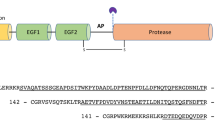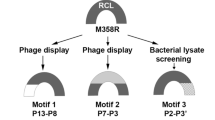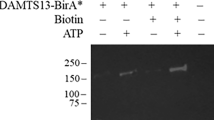Abstract
BLOOD coagulation can be initiated when factor VII or VIla, a plasma protease, binds to its essential cofactor, tissue factor (TF), and proteolytically activates factors IX and X1,2, triggering a cascade of events which eventually leads to the formation of thrombin and a fibrin clot. Plasma contains a lipoprotein-associated coagulation inhibitor (LACI) which inhibits activated factor X (Xa) directly and, in a Xa-dependent way, inhibits VII(a)/TF activity, presumably by forming a quaternary Xa/LACI/VII(a)/TF complex3–5. Sequence analysis of complementary DNA clones has shown that LACI contains three tandemly repeated Kunitz-type serine protease inhibitory domains6,7. To investigate the relationship between these Kunitz structures and LACI function, we have used site-directed mutagenesis to produce altered forms of LACI in which the residue at the active-site cleft of each Kunitz domain has been individually changed. The second Kunitz domain is required for efficient binding and inhibition of Xa, and both Kunitz domains 1 and 2 are required for the inhibition of VIIa/TF activity; but alteration of the active-site residue of the third Kunitz domain has no significant effect on either function. We propose that in the putative inhibitory complex, Kunitz domain 1 is bound to the active site of VII(a)/TF and that Kunitz domain 2 is bound to Xa's active site.
This is a preview of subscription content, access via your institution
Access options
Subscribe to this journal
Receive 51 print issues and online access
$199.00 per year
only $3.90 per issue
Buy this article
- Purchase on SpringerLink
- Instant access to full article PDF
Prices may be subject to local taxes which are calculated during checkout
Similar content being viewed by others
References
Silverberg, S. A., Nemerson, Y. & Zur, M. J. biol. Chem. 252, 8481–8488 (1977).
Zur, M. & Nemerson, Y. J. biol. Chem. 255, 5703–5707 (1980).
Broze, G. J. Jr et al. Blood 71, 335–343 (1988).
Sanders, N. L., Bajaj, S. P., Zivelin, A. & Rapaport, S. I. Blood 66, 204–212 (1985).
Hubbard, A. R. & Jennings, C. A. Thromb. Res. 46, 527–537 (1987).
Wun, T.-C., Kretzmer, K. K., Girard, T. J., Miletich, J. P. & Broze, G. J. Jr J. biol. Chem. 263, 6001–6004 (1988).
Girard, T. J. et al. Nucleic Acids Res., submitted.
Berger, A. & Schechter, I. Phil. Trans. R. Soc. B 257, 249–264 (1970).
Wenzel, H. R. & Tschesche, H. Angew. Chem. Int. Ed. Engl. 20, 295–296 (1981).
Novotny, W. F., Girard, T. J., Miletich, J. P. & Broze, G. J. Jr Blood 72, 2020–2025 (1988).
Zoller, M. J. & Smith, M. Meth. Enzym. 100, 468–500 (1983).
Sanger, F., Nicklen, S. & Coulson, A. R. Proc. natn. Acad. Sci. U.S.A. 83, 6776–6780 (1977).
Howley, P. M., Sarver, N. & Law, M. F. Meth. Enzym. 101, 387–403 (1983).
Broze, G. J. Jr, Warren, L. A., Girard, J. J. & Miletich, J. P. Thmmb. Res. 48, 253–259 (1987).
Miletich, J. P., Sherman, L. & Broze, G. J. Jr New Engl. J. Med. 317, 991–996 (1987).
Author information
Authors and Affiliations
Rights and permissions
About this article
Cite this article
Girard, T., Warren, L., Novotny, W. et al. Functional significance of the Kunitz-type inhibitory domains of lipoprotein-associated coagulation inhibitor. Nature 338, 518–520 (1989). https://doi.org/10.1038/338518a0
Received:
Accepted:
Issue Date:
DOI: https://doi.org/10.1038/338518a0
This article is cited by
-
Mutational analysis of pig tissue factor pathway inhibitor α to increase anti-coagulation activity in pig-to-human xenotransplantation
Biotechnology Letters (2024)
-
TFPI inhibits breast cancer progression by suppressing ERK/p38 MAPK signaling pathway
Genes & Genomics (2022)
-
Expression analysis of tissue factor pathway inhibitors TFPI-1 and TFPI-2 in Paralichthys olivaceus and antibacterial and anticancer activity of derived peptides
Veterinary Research (2021)
-
Knockdown screening of chromatin binding and regulatory proteins in zebrafish identified Suz12b as a regulator of tfpia and an antithrombotic drug target
Scientific Reports (2021)
-
Production and control of coagulation proteins for factor X activation in human endothelial cells and fibroblasts
Scientific Reports (2020)



